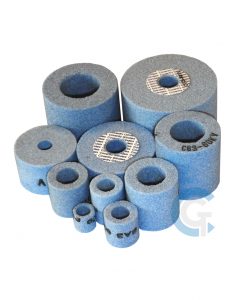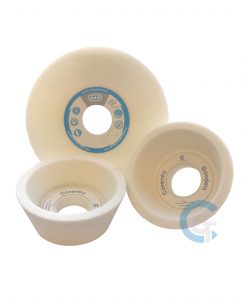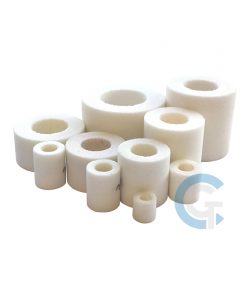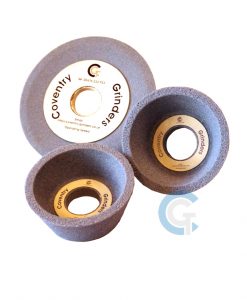Pink Grinding Wheels
£4.80 – £114.00 Inc. VAT
Pink wheels are made from Pink aluminium oxide which is a highly refined form of alumina containing a small proportion of chromium oxide. This addition makes pink wheels a little tougher then pure white aluminium oxide. This increases the strength along the shear planes. See below for a more detailed description.
Pink Grinding wheels
are made from Pink aluminium oxide which is a highly refined form of alumina containing a small proportion of chromium oxide. This addition makes pink wheels a little tougher then pure white aluminium oxide. This increases the strength along the shear planes. This abrasive is available in range of wheels here on this site. You also often see it on mounted points.
WHAT IS A GRINDING WHEEL?
A grinding wheel is a precision tool with thousands of cutting points. It consists of abrasive grains held in a matrix of bond and separated by pores. The abrasive grains are the cutting points while the purpose of the bond is to hold the individual grains together. The pores (hollow spaces between adjacent abrasive grains and the bond) serve to provide clearance for coolant penetration and metal chips removed in the grinding process.
When the wheel is rotated at grinding speed and applied to the work-piece, the abrasive grains cut the material that is being ground, removing the material in small chips.
Under the action of the forces imposed during grinding the abrasive cutting points are worn flat, resulting in the points becoming blunt. This causes an increase in friction, and a build-up of heat.
The increase in grinding forces causes either the abrasive to fracture, exposing new cutting edges, or fractures the bond bridges holding the abrasive grains. In the latter case fresh abrasive grains are exposed to cut the work-piece.
In normal vitrified grinding applications, the wheel has to be dressed.
By varying the properties of the abrasive, the type of bond, the make-up of the wheel, it is possible to produce grinding wheels with vast range of different grinding characteristics.
SELECTING THE RIGHT PRODUCT
THERE ARE NINE MAIN FACTORS TO BE CONSIDERED WHEN SELECTING A GRINDING WHEEL FOR ANY APPLICATION:
- The material to be ground – its type and hardness
- The stock to be removed
- The workpiece geometry and surface finishes required
- The grinding machine, the type of machine, the power available and its conditions
- Wheel speeds and feeds
- Grinding contact area
- Grinding fluid – whether the operation is wet or dry
- The severity of the grinding operation
- The dressing method.
MATERIAL TO BE GROUND
The type of material affects the selection of abrasive, grit size and grade. Alumina type abrasives are the most suitable for grinding high tensile materials such as steel and ferritic cast iron. The more friable types of alumina are preferred on harder steels and applications having large arcs of contact. Low tensile strength materials and non-metallic materials are most efficiently ground or cut with silicon carbide abrasive. The hardness of the material governs the amount of penetration that can be achieved by the abrasive. For this reason, finer grit size wheels are required to grind hard materials and soft materials are best ground with medium to coarse grit size wheels. For most efficient operation, the grade must be adjusted to suit the hardness of the material. As a general guide, the harder the material, the softer the grade of wheel required.
STOCK TO BE REMOVED
This affects the choice of abrasive size and bond type.
High stock removal rates, as in fettling operations, require coarse grit wheels, typically 12 to 24 mesh.
Fine finishes and tight limits on finished workpiece geometry require finer grit sizes.
Final surface finish is often achieved by spark out. No further infeed is applied and the wheel is allowed to grind until the majority of the grinding sparks cease.
GRIT SIZE
The number in the grinding wheel, marking designating grit size, represents the approximate number of openings per linear inch in the final screen size used to size the grain. The following rules should be followed:
USE COARSE GRIT
Including and smaller than 46 Grit.
• For soft, ductile, stringy materials such as soft steel or aluminium
• For rapid stock removal
• Where finish is not important
• For large areas of contact
USE FINE GRIT
Including and greater than 60 grit.
• For hard, brittle materials such as hard tool steels, cemented carbides and glass
• For fine finishes
• For small areas of contact
• For holding small corner radii
SURFACE FINISH
The achievable surface finish in any grinding operation is highly dependent upon the grit size of the grinding wheel. The following chart shows the range of surface finishes achievable when using grinding wheels of different grit sizes on conventional precision grinding applications, together with the minimum form radius that can be ground using each grit size.
Other factors can affect the surface finish achieved. In particular:
- Production grinding applications, with higher stock removal ranges, will give surface finishes at the coarser end of the range
- Plunge grinding applications will often require the selection of a grit size one size finer than shown
- Dressing techniques & the type of material can also affect the surface finish achieved
| Surface Finish & Grit Size | |||||||||
| Surface | Surface | Grain Size | |||||||
| In CLA | In Ra | 46 | 60 | 80 | 100 | 120 | 150 | 180 | 220 |
| 42 | 1.10 | * | |||||||
| 32 | 0.80 | * | |||||||
| 26 | 0.70 | * | |||||||
| 21 | 0.50 | * | |||||||
| 16 | 0.40 | * | |||||||
| 14 | 0.35 | * | * | ||||||
| 11 | 0.25 | * | * | ||||||
| 8 | 0.20 | * | * | ||||||
| 7 | 0.17 | * | * | * | |||||
| 6 | 0.14 | * | * | * | |||||
| 5 | 0.12 | * | * | * | |||||
| 4 | 0.10 | * | * | * | |||||
| 3 | 0.08 | * | * | ||||||
| 2 | 0.05 | * | |||||||
| Min Form | Metric | 0.75 | 0.5 | 0.4 | 0.25 | 0.2 | 0.18 | 0.13 | 0.1 |
| Radius | Imperial | 0.030 | 0.020 | 0.015 | 0.010 | 0.008 | 0.007 | 0.005 | 0.004 |
Achieving Improved Surface Finishes
By changing the wheel dressing technique, it is possible to achieve finer surface finishes than those shown. As well as reducing the dresser infeed per revolution of the grinding wheel, it is also possible to reduce the infeed and traverse rate when grinding, thus reducing the stock removal rate. Obviously this approach will have limited application in production grinding but it can be very useful in tool room work.
Related products
Our Grinding Wheels
Our Grinding Wheels
Our Grinding Wheels
Our Grinding Wheels






